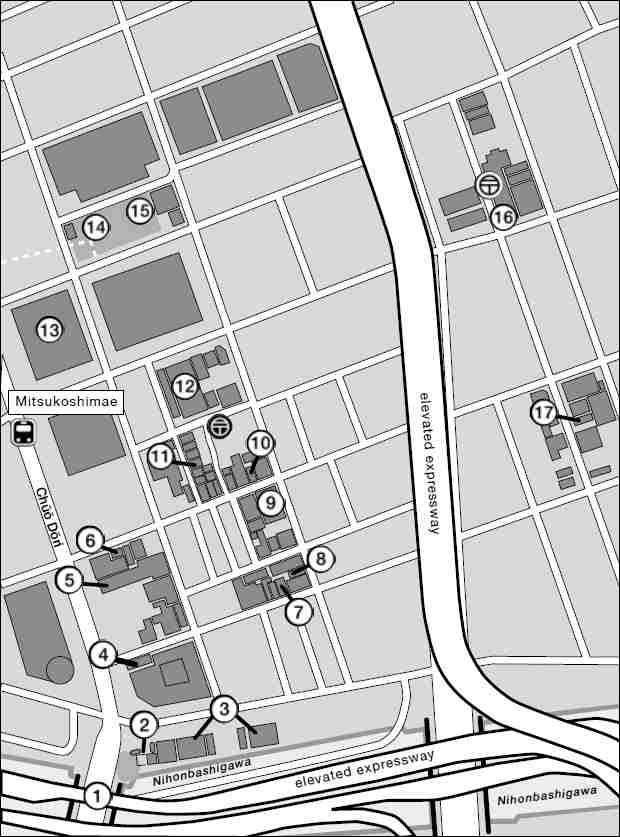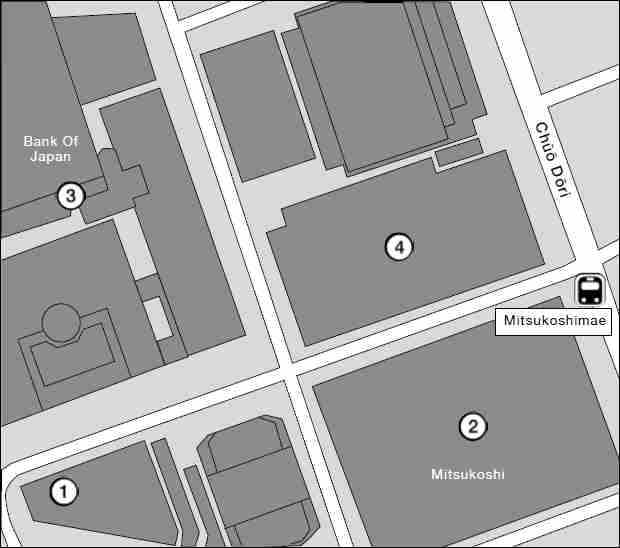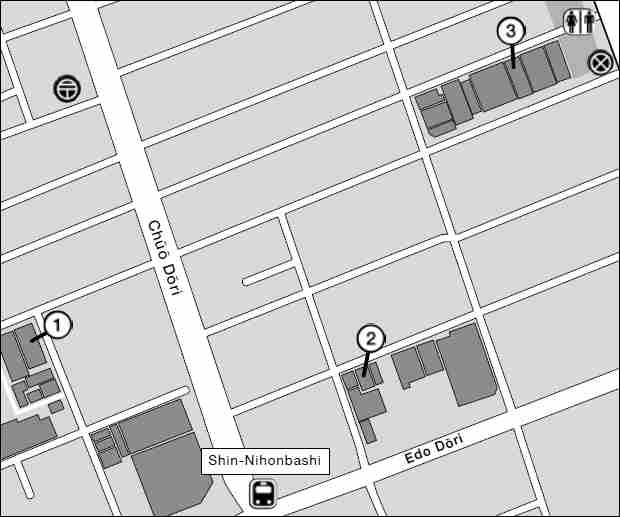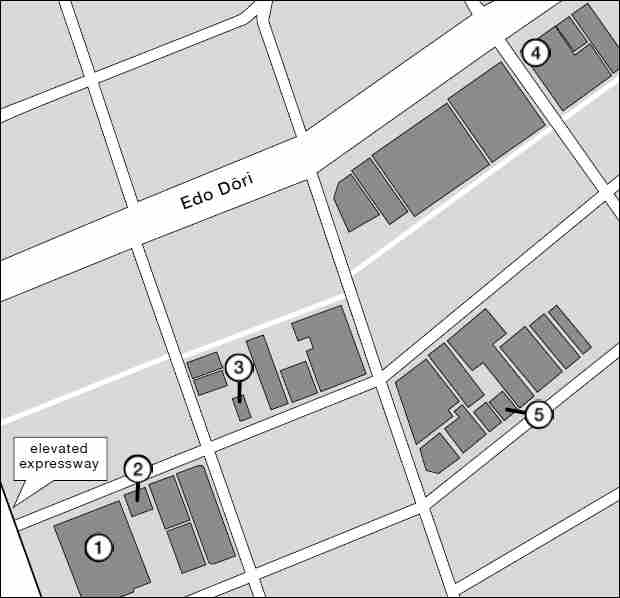日本橋地区 北部
NIHONBASHI NORTH
Here we are getting into one of the oldest parts of the city. When Tokugawa Ieyasu first planned the laying out of the town, he reserved most of the high city for the samurai and the low city for the commoners. Nihonbashi was designated as the central market area in the low city, close enough to the shōgun’s castle to be a food distribution point for both the high and low cities. While the market moved to Tsukiji after the Great Kantō Earthquake, one can still find several stores that continue to deal in products from that period. Nihonbashi as a name will crop up here in more than one context. It is the name of a major bridge in the district, which gave its name to the district on either side of it, and to the local river, the Nihonbashigawa. In Nihonbashi you will find temples, shrines, long-established shops, historical landmarks, museums, government offices, plenty of places to eat, and more.
This section covers the northern portion of Nihonbashi in the vicinity of the bridge. See the following chapter for the portion south of the bridge and nearby areas.
DETAIL 1
A bridge originally built of wood in 1603. In 1604 the location of this bridge was designated as the zero point in measuring distances from the city. Modern signs that state the distance to Tokyo still refer to this location. The current Western-style granite bridge with its large brass lanterns sporting lions and winged kirin dates from 1911. A cleaning in preparation for the centenary of the current bridge intentionally left visible damage from the Great Kantō Earthquake of 1923 and the World War II firebombings, as a relic of important parts of its history. Above the bridge, following the Nihonbashigawa, is an expressway built shortly before the 1964 Tokyo Olympics. Plans to remove the roadway are being developed, eventually replacing it with a massive tunnel system to carry the traffic. The large calligraphy on the expressway above the bridge says Nihonbashi and is based on that of the last shōgun, Tokugawa Yoshinobu.
NOTE: Since 1971, the bridge is closed to traffic for one day and cleaned by a team of volunteers from the Meikyō Nihonbashi Hozonkai, “The Famed Nihonbashi Bridge Preservation Society.” Only members of the organization can participate; the public is not allowed to join in.
NIHONBASHI NORTH
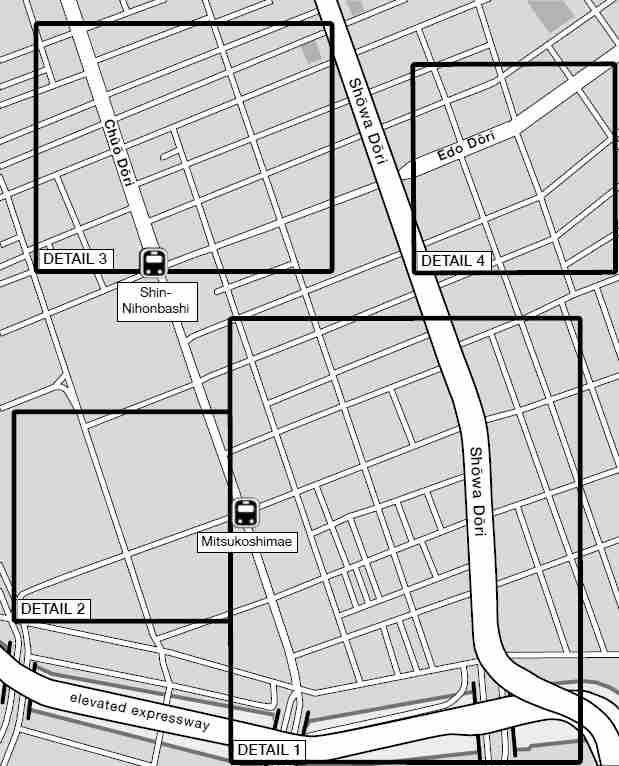
NIHONBASHI NORTH DETAIL 1
 Nihonbashi Fish Market Monument / Nihonbashi Uoichiba Hasshō no Chi-hi 日本橋魚市場発祥の地碑
Nihonbashi Fish Market Monument / Nihonbashi Uoichiba Hasshō no Chi-hi 日本橋魚市場発祥の地碑
From the days of the founding of Edo, this was the location of the fish market for the city. During that time, fish from Tokyo Bay would be freshly delivered to the market by boat on the Nihonbashigawa and available for the citizens to buy. Along with the market grew a variety of other businesses, including places where merchants or laborers could rest and have a cup of tea or a snack. The 1923 Great Kantō Earthquake severely damaged the market and it was decided to move it to another location. In 1935 the new fish market opened at Tsukiji and the Nihonbashi market closed.
 Kite Museum / Tako no Hakubutsukan 凧の博物館
Kite Museum / Tako no Hakubutsukan 凧の博物館
This museum was founded by the late Motegi Shingo, the owner of the Taimeiken restaurant, who had amassed a large private collection of kites. It is located a few doors west of the restaurant on a second floor. While focusing on Japanese kites, it also contains kites from around the world. Only a few hundred of the thousands of kites in the collection are on display at any one time, due to limited space.
Established in 1931, Taimeiken serves Western-style Japanese dishes in a relaxed atmosphere. Beef stew, croquettes, omelet rice, hamburger steak, and pasta are some of the dishes offered. If you have seen the movie Tampopo, you will recognize the omelet rice served here. This version of omelet rice is apparently based on a recipe developed for the movie by the restaurant. That scene was filmed in the second floor kitchen, and the hands you see in the close-up shots were those of the owner.
This is located near the Kite Museum, which is on the second floor a few doors west of the restaurant. This place is popular, so you may have to wait.
Founded in 1737 as a store specializing in dried ingredients for dashi, the ubiquitous Japanese stock used in soup, stews, and cooking. This means of course katsuobushi, in both the solid and various flake forms, premixed dashi powder, bottled dashi, shiitake from various parts of Japan, a variety of seaweed, dried beans, furikake, dried noodles, and more. The dry nature of many of these products means they are lightweight and perfect to bring home for those who love to cook.
 http://www.yagicho-honten.jp
http://www.yagicho-honten.jp
This nine-story building is the main store of the chain specializing in one thing: nori, those sheets of seaweed used in a variety of ways in Japanese cuisine. In business since 1849, they sell not only plain nori but also certain product lines of seasoned nori, nori-based furikake, nori tsukudani, and various nori snacks. Hello Kitty seaweed chips anyone?
 http://www.yamamoto-noriten.co.jp
http://www.yamamoto-noriten.co.jp
 http://www.norenkai.net/en/portfolio-item/yamamoto-nori-ten/
http://www.norenkai.net/en/portfolio-item/yamamoto-nori-ten/
Established in 1912, Yūbendō sells supplies for calligraphy and traditional painting: everything from brushes and paper to a large variety of pigments. They also handle items made with traditional paper, and do picture framing.
 William Adams’ House Memorial / Miura Anjin Kyū Kyo Ato 三浦按針旧居跡
William Adams’ House Memorial / Miura Anjin Kyū Kyo Ato 三浦按針旧居跡
Englishman William Adams was the navigator for a group of Dutch ships that sailed across the Pacific, via the tip of South America, from Europe to Japan. Only one ship, the De Liefde, made it all the way, landing in 1600. Adams so impressed shōgun Tokugawa Ieyasu that he not only made him and the second mate Jan Joosten samurai, but also gave them the high rank of hatamoto. Adams was to spend the rest of his life in Japan, with the exception of a few trading voyages, and died there in 1620. He worked to improve shipbuilding, assisted in expanding trade with the Dutch and British, and advised the shōgun on many topics. The monument to his home is next to Tagawa Jewels on Anjin Dōri. The word anjin means navigator. The monument stone first put up in 1930 was destroyed in World War II; the present stone dates from 1951. Many English speakers will be familiar with Adams as the character John Blackthorne in the highly fictionalized and historically inaccurate account in the novel Shogun.
This was Japan’s first take-out bentō shop. Established as an eatery in 1850, the clientele were mainly people who worked at the Nihonbashi fish market. The busy customers often had little time to eat at the restaurant, so they would often take the rest of their meal with them. Offering takeout seemed a good choice to the owner, so he changed the business to takeout only. The food has a good old hearty Edo-style flavoring, which some find rather strong. The disposable boxes are still made of folded thin wood rather than cardboard or plastic.
 http://www.norenkai.net/en/portfolio-item/benmatsu/
http://www.norenkai.net/en/portfolio-item/benmatsu/
Kanmo has been making and selling processed seafood products since 1688. The most famous products are their hanpen and kamaboko. These two products are made with ground shark (hanpen) or fish (kamaboko) made into a paste and then mixed with other ingredients such as yam or eggs (or both) to thicken, then steamed or boiled until set. Hanpen is sometimes eaten grilled, and both can be ingredients in other dishes such as oden or ramen.
 http://www.norenkai.net/en/portfolio-item/kanmo/
http://www.norenkai.net/en/portfolio-item/kanmo/
A small ramen restaurant, the type of place businessmen go to for a quick lunch. They have a nice variety of ramen dishes and use whole-wheat flour in their noodles. At the entrance there is a ticket machine where you make your selection. Open during the week for lunch and dinner, lunch only on Saturdays. English speaking staff, non-smoking.
In operation since 1704, this is the only shop in Japan specializing in traditional handcrafted kuromoji, somewhat confusingly translated as “toothpicks.” Kuromoji are not to be confused with simple thin store-bought toothpicks. While these can be used to pick your teeth, they are mainly intended for slicing and eating traditional tea sweets. Saruya’s kuromoji are handcrafted and sold in boxes made of kiri wood with attractive designs on them. You can even place advanced orders for boxes with personalized calligraphy on the labels, useful as a special gift.
 http://www.nihonbashi-saruya.co.jp
http://www.nihonbashi-saruya.co.jp
 http://www.norenkai.net/en/portfolio-item/saruya/
http://www.norenkai.net/en/portfolio-item/saruya/
A maker of castella cake, baumkuchen, and other baked sweets both European and Japanese. The history of Bunmeidō is one of perseverance through the ups and downs of the 20th century. The company dates from 1900 and was originally in Nagasaki. In 1922 they opened their Tokyo branch, which then burned down in the Great Kantō Earthquake. In 1933 they opened a new store in Shinjuku, then in 1939 in the Ginza. In 1941 they had to cancel production due to a shortage of supplies, and in 1945 the store was destroyed in the firebombings of World War II. In 1950 they were able to resume production and in 1951 opened the Nihonbashi store. Since then the company has greatly expanded, with production facilities and shops in various parts of Japan. You can make purchases to go or enjoy something in the attached cafe.
The Kiya cutlery store shares the same name as an older shop named Kiya. The owner of the first gave permission in 1792 to an apprentice to use the name as long as he did not sell the same products. At one time there were several Kiya stores with this arrangement in the Nihonbashi. While kitchen knives form their major product line, they also sell other kitchen items such as sharpening stones, scissors, pots, and ceramics. They also repair and sharpen blades. The location is on the first floor of the COREDO Muromachi 1 building.
 http://www.kiya-hamono.co.jp
http://www.kiya-hamono.co.jp
 Nihonbashi Information Center 日本橋案内所
Nihonbashi Information Center 日本橋案内所
You may want to make this an early stop when visiting the neighborhood. Information centers will often have notices of special events and can suggest places to see. The center is located in the B1 level of the COREDO Muromachi 1 building and is directly accessible from Mitsukoshimae Station.
 http://www.nihonbashi-tokyo.jp/en/information_center/
http://www.nihonbashi-tokyo.jp/en/information_center/
Founded in 1699, this shop now specializes in katsuobushi, either whole or shaved in bags. They also sell katsuobushi kezuriki, a box with an inverted plane for shaving your own flakes at home. Also available are several types of bottled dashi, the traditional cooking stock of Japan, and furikake. The shop is located in the COREDO Muromachi 1 building on the first floor. They also have a restaurant in the same building which is open from 11:00 a.m. to 11:00 p.m.
 http://www.norenkai.net/en/portfolio-item/ninben/
http://www.norenkai.net/en/portfolio-item/ninben/
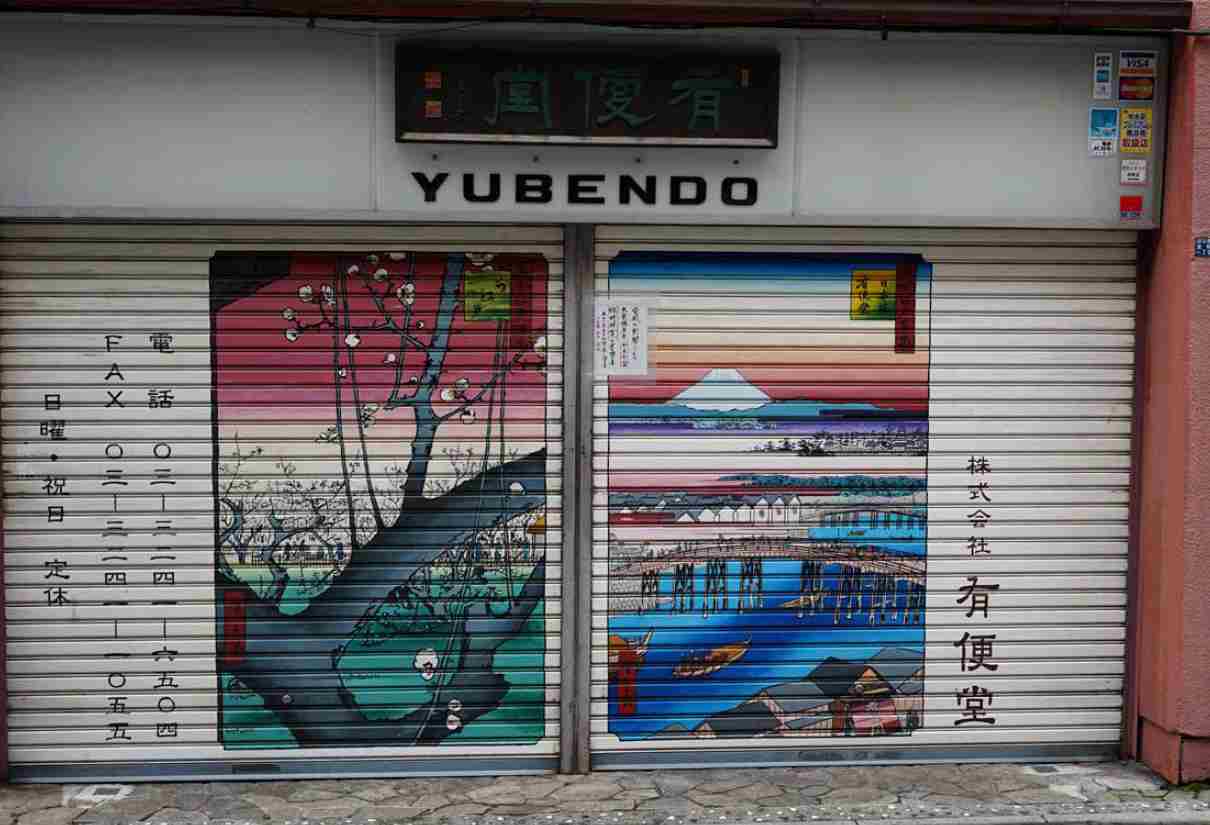
▲ The adorned shutters of paint supply store Yūbendō can be seen in the early morning.
Established in the 9th century, this is a shrine to Uka no Mitama no kami, “the spirit of the rice in storehouses,” who is also identified with Inari. Also enshrined here are Ōta Dōkan, Benten, and Tokugawa Ieyasu. It is also known by the nickname Mebuki (“sprouting”) Jinja, as one of the fresh gate pillars once sprouted a shoot. In the Edo period this shrine was one of very few allowed to hold fundraising lotteries. Due to this association, people hoping to win lotteries come here to pray. The shrine underwent a complete renovation in 2014.
Ōnamuji no Mikoto and Sukunahikona no Mikoto are enshrined here as medicinal kami. This neighborhood has been a center for pharmaceutical companies since the Edo Period. In 1929 the first shrine was placed on the pharmaceutical guild office’s roof, in 2016 it was moved to the present site. The annual festival is on October 17.
This shop sells traditional flat and folding fans. The range of styles is very large; the patterns on the fans can vary from simple and elegant designs to reproductions of ukiyo-e prints. The business was founded in 1590. Given their long history it is not surprising that their fans are in the collections of many museums, such as the Van Gogh Museum, The British Museum, and The Metropolitan Museum of Art.
 http://www.norenkai.net/en/portfolio-item/ibasen/
http://www.norenkai.net/en/portfolio-item/ibasen/
Operating since 1842, Chikusen sells fabric for yukata and kimono in a large selection of designs. The kimono fabrics are done in the Edo komon style, which involves subdued patterns made up of small hand-stenciled dots on silk. The yukata are cotton with lively broad patterns and are perfect for festivals in the warmer months. Their products are sold in many other stores in Japan.
 http://www.norenkai.net/en/portfolio-item/chikusen/
http://www.norenkai.net/en/portfolio-item/chikusen/
DETAIL 2
 Bank of Japan Currency Museum / Nippon Ginkō Kin’yū Kenkyūjo Kahei Hakubutsukan 日本銀行金融研究所貨幣博物館
Bank of Japan Currency Museum / Nippon Ginkō Kin’yū Kenkyūjo Kahei Hakubutsukan 日本銀行金融研究所貨幣博物館
This museum opened in 1985 and is operated by the Institute for Monetary and Economic Studies of the Bank of Japan. The museum is free; as it is in a secure building, metal detectors and x-ray machines are used to inspect visitors’ belongings. The displays cover the history of Japanese currency from the early days of the use of coinage to the present. Included are commodities that were used for exchange before coinage entered Japan, up until the development and standardization of paper currency, which started around 1600. World currencies are also displayed to illustrate their development. The exhibits are very well laid out with some English captions. There is a Japanese-English guidebook available.
 http://www.imes.boj.or.jp/cm/english/
http://www.imes.boj.or.jp/cm/english/
NIHONBASHI NORTH DETAIL 2
The main department store of the Mitsukoshi company. Originally called Echigoya, this store was established in 1673 during the Edo period as a kimono fabric shop. The name changed in the Meiji period, as did the stock of the store. The present building was built in 1914 and consists of seven stories plus one basement level. There is also an annex with ten stories plus two basement levels. From the lion sculptures at the entrance—reminiscent of Trafalgar Square—to the rooftop, this store is a delight to the eyes. A centerpiece is the massive hinoki wood sculpture of magokoro, “sincerity,” by Satō Gengen that rises for four stories in the middle of the grand stairway. As is typical of such large department stores in Japan, a significant portion of the building is devoted to space rented to specialized businesses selling their own products. There is also an exhibit space that is worth checking out. The rooftop is a good place to rest. It includes a gardening section, as well as a branch of Mimeguri Jinja in Sumida Ward, which has been long associated with the Mitsui family. Given the size of the store, you may want to grab their brochure at the entrance and head to the roof to sit and plan your route. Several restaurants lease space in the building, and you can find places to eat on more than one floor.
 https://cp.mistore.jp/global/en/nihombashi.html
https://cp.mistore.jp/global/en/nihombashi.html
Mitsukoshi Lions
Some trivia regarding the lions out front: They are smaller versions of the originals, which were designed and cast for the store by British sculptors Merrifield and Barton and shipped to Japan. During the war the Imperial Navy impounded them to be melted down and made into weaponry. After the war the lions were found in storage and returned.
 Bank of Japan / Nippon Ginkō 日本銀行
Bank of Japan / Nippon Ginkō 日本銀行
While the Bank of Japan was founded in 1882, of main interest will be the Neo-Baroque old building, which was completed in 1896 and stands on the location of an old Edo period mint. The architect was Tatsuno Kingo, who also designed Tokyo Station. To the left as you face the structure is the new building, and across the street to the right is the annex. Both of these are rather functional office buildings without the symbolic grandeur of the old building. This being a government office, access to parts of the building is restricted. Tours, with advanced reservation only, are possible for groups of between five and twenty.
Tours of the Bank’s Head Office:
 https://www.boj.or.jp/en/about/services/kengaku.htm/
https://www.boj.or.jp/en/about/services/kengaku.htm/
 Mitsui Memorial Museum / Mitsui Kinen Bijutsukan 三井記念美術館
Mitsui Memorial Museum / Mitsui Kinen Bijutsukan 三井記念美術館
A fine collection of Japanese art collected over 300 years by the Mitsui family. The predecessor to the museum was the Mitsui Library in Nakano Ward. The present museum opened on the seventh floor of the Mitsui Main Building in 2005. It is relatively small, just six galleries and a lecture hall. However the quality of the works displayed is very high. The museum includes a detailed replica of the interior of the famous Joan tea ceremony room, a cafe, and a museum shop. They also publish catalogs for their special exhibits and other works. Thematic special exhibits are common.
 http://mitsui-museum.jp/english/english.html
http://mitsui-museum.jp/english/english.html
NIHONBASHI NORTH DETAIL 3
DETAIL 3
Founded in 1869, this restaurant serves two types of cold soba: zarusoba and morisoba. You can also order tempura to go along with your soba—just order tenzaru or tenmori soba. They have rooms on the second floor that can be reserved for parties. Seating is both tatami and Western style.
 http://norenkai.net/en/portfolio-item/muromachi-sunaba-2/
http://norenkai.net/en/portfolio-item/muromachi-sunaba-2/
Originally, in 1885, this was a stall on the street. In 1907 the owner settled into a restaurant, and the current building dates from 1947. Their tempura is made in the Edo style using sesame oil and is served in set meals. The ingredients change throughout the year along with the seasons. Seating is both traditional on tatami and Western style in chairs. Nonsmoking.
 http://tenmo.jp/e-index.html
http://tenmo.jp/e-index.html
An excellent example of the many small Shintō shrines that dot the city. The location is on a narrow side street surrounded by taller buildings. This one is unusual in that it is completely enclosed in a tiny structure to protect it from the elements.
DETAIL 4
This shop has been in the same location since 1653. The original name was Ozu Seizaemon-ten. This large three-story store specializes in traditional washi paper and various products made from it. Picture framing and scroll mounting are also provided. The location includes an exhibit space and a museum on the history of the store. They also offer workshops on papermaking, calligraphy, and ink painting.
Founded in 1946, this company specializes in high-quality Edo kiriko cut glass. Originally a subcontractor for a major glass company, the founder’s son decided to break away from that model and go into direct sales. This is their second store, which opened in Nihonbashi in 2016. The company holds several patents for their designs.
 http://www.hanashyo.com/index.html
http://www.hanashyo.com/index.html
Ebisu, one of the Shichifukujin, is enshrined here. The statue of Ebisu in the shrine was given to the locals by Tokugawa Ieyasu in 1606. While the statue is usually not displayed, it is shown from January 1–7, and during the Bettara Ichi Fair held on the October 19 and 20. The Bettara Ichi Fair is famous for the sale of a type of pickled daikon called bettarazuke. There is also a variety of other foods available. At night the festival is lit up by some 1,500 lanterns, so you may want to visit then. People often pray here for business, family prosperity, and fire protection.
A shop established in 1673 specializing in paper elements for the home: shoji screens, fusuma partitions, sliding doors, wallpaper, decorative items, and a variety of paper accessories. They also sell some ceramics. All are handmade.
 http://www.3k-kawashima.co.jp
http://www.3k-kawashima.co.jp
NIHONBASHI NORTH DETAIL 4
The founder of Edoya was trained in Kyoto and became the maker of cleaning brushes for the shōgun’s household. In 1718 he was able to obtain permission to open a shop selling his products. The store is still operating in the original location and sells all sorts of brushes. In the Meiji period the product line was expanded to include brushes that reflected social changes, such as brushes for cleaning Western-style clothing. This is a good place to go if you are looking for a finely made boar bristle brush designed to be used with wool, or a cleaning brush made from horsehair. The brushes are all handmade with natural products.
